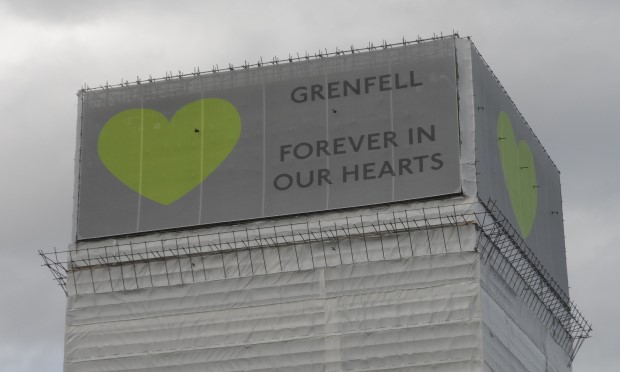‘Long overdue’: Any council tower block taller than 30 metres to get ‘alternative evacuation route’

Grenfell Tower, pictured a few days after the one-year anniversary of the tragedy. Photograph: Carcharoth
Any tower block higher than 30 metres at a council development will get a second staircase to boost fire safety, Town Hall bosses have pledged.
Hackney Council said it will look again at its building projects – including the tall towers at the Britannia leisure centre redevelopment – to see if any could do with a second flight of stairs.
The move would give residents an alternative way of getting out in an emergency.
Last month, Mayor of London Sadiq Khan said planning applications for all tower blocks higher than 30 metres will have to include a second staircase.
It follows a government consultation about making a second staircase mandatory as part of safety measures after the 2017 Grenfell Tower fire, in which 72 people died. The west London tower block had 24 storeys at a total of 67 metres in height.
Jules Pipe, London’s deputy mayor for planning, regeneration and skills, explained: “The Mayor has consistently expressed concerns that the fire safety requirements in the national building regulations are not fit for purpose.”
Developers have blamed the extra cost as a reason for not including a second staircase in tower blocks.
Historic buildings such as the 1972 Trellick Tower in west London were constructed with a second set of steps.
The Greater London Authority is working with councils to ensure their housing developments which have already had planning permission include two flights.
Hackney Council pledged to work with the contractor of its redevelopment of the Britannia leisure centre site to add a second staircase in the three towers taller than 30 metres.
Pat Turnbull from the Save Britannia Leisure Centre campaign welcomed the move.
She said: “The campaign had written to the council several times on the question of the single staircases, most recently pointing out the advice from the Mayor of London.”
She added: “It has taken the council a long time to come to the conclusion second staircases were necessary. The original planning permission was approved in November 2018, already a year and a half after the Grenfell Tower tragedy, and the council persisted with the original plans even when the reserved matters came before the planning committee more recently.
“We will be following closely what happens next. And we still object to the large number of market units – 314 – compared to the 51 social rented homes, and to the effect of these huge towers on the residents of the surrounding area.”
Last May, residents who raised concerns about single staircases in the 20- and 25-storey towers on the site were told by council officials: “The fire strategy for all of the buildings has been developed alongside professional fire engineers, and we are confident that the design maximises the fire safety of the building and meets building regulations for high-rise residential buildings.
“Single stair buildings are compliant with these regulations, provided that mitigations are in place to maintain a high level of fire safety for both occupants and the fire service.”
They said this included compartmentation between homes, floors, stairs and other spaces, a smoke control system, and the use of a “stay put” evacuation strategy which could be changed to “all-out” if firefighters thought it necessary.
Responding to the government consultation, Hackney Mayor Philip Glanville urged the expected government rules to go further, with second staircases needed for buildings 18 metres or higher.
He told Michael Gove, the secretary of state for levelling up, housing and communities: “While requirements around second staircases are long overdue, however, we would strongly encourage you to go further than your proposal and follow the recommendation from the National Fire Chiefs Council that all buildings above 18m, rather than 30m, should incorporate a second staircase.”
He added: “We would also like to flag that, regardless of the outcome of this consultation, new homes being built today and in the future will benefit from a whole raft of recent safety requirements.
“In an urban borough like Hackney, which is expected to see major high-density development in the years ahead, higher standards would give more residents the reassurance of an alternative evacuation route and better access for emergency services in the event of a fire.”
